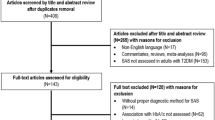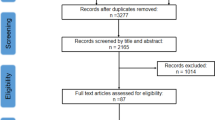Abstract
Obstructive sleep apnea (OSA) has many serious consequences, and one of these may be the exacerbation of type 2 diabetes mellitus (T2DM). Reports on the effect of continuous positive airway pressure (CPAP) on glucose metabolism in people with T2DM and OSA are conflicting. Therefore, the purpose of this review was to examine the effect of CPAP treatment on glucose metabolism by synthesizing findings from randomized controlled trials. The PRISMA review protocol was developed and registered in PROSPERO. A systematic search of PubMed, CINAHL, Embase, Web of Science, PsycInfo, and Cochrane was conducted from inception to March 2017. The Cochrane risk of bias tool was used to assess the study quality. Review Manager (v5.2) was used for the meta-analyses, and the standardized mean difference was calculated. Six studies consisting of 496 participants were included in this review. The meta-analyses indicated that CPAP treatment did not have significant impact on glucose metabolism measured by A1C (mean difference = 0.05, 95% CI − 0.14 to 0.24, P = 0.61), fasting insulin level (mean difference = − 2.34, 95% CI − 8.19 to 3.51, P = 0.43), and fasting glucose (mean difference = − 0.05, 95% CI − 0.52 to 0.42, P = 0.84). As expected, CPAP treatment can improve daytime sleepiness (mean difference = − 2.68, 95% CI − 3.91 to − 1.54, P < 0.001). Findings of this meta-analysis do not substantiate a positive effect of CPAP on glucose metabolism in people with T2DM and coexisting OSA. Future large-scale clinical trials with a longer treatment duration and better CPAP compliance are warranted.




Similar content being viewed by others
References
International Diabetes Federation (2015) Diabetes: Facts and figures http://www.idf.org/about-diabetes/facts-figures. Accessed 2 April 2017
Ozieh MN, Bishu KG, Dismuke CE, Egede LE (2015) Trends in health care expenditure in US adults with diabetes: 2002–2011. Diabetes Care 38:1844–1851
Nagayoshi M, Punjabi NM, Selvin E, Pankow JS, Shahar E, Iso H, Folsom AR, Lutsey PL (2016) Obstructive sleep apnea and incident type 2 diabetes. Sleep Med 25:156–161
Anothaisintawee T, Reutrakul S, Van Cauter E, Thakkinstian A (2016) Sleep disturbances compared to traditional risk factors for diabetes development: systematic review and meta-analysis. Sleep Med Rev 30:11–24
Rajan P, Greenberg H (2015) Obstructive sleep apnea as a risk factor for type 2 diabetes mellitus. Nat Sci Sleep 7:113–125
Flemons WW, Buysse D, Redline S, Oack A, Strohl K, Wheatley J, Young T, Douglas N, Levy P, McNicolas W (1999) Sleep-related breathing disorders in adults. Sleep 22:667–689
Franklin KA, Lindberg E (2015) Obstructive sleep apnea is a common disorder in the population—a review on the epidemiology of sleep apnea. J Thorac Dis 7:1311–1322
American Academy of Sleep Medicine (2016) Hidden health crisis costing America billions: underdiagnosing and undertreating obstructive sleep apnea draining healthcare system http://www.aasmnet.org/Resources/pdf/sleep-apnea-economic-crisis.pdf. Accessed 2 April 2017
Pamidi S, Tasali E (2012) Obstructive sleep apnea and type 2 diabetes: is there a link? Front Neurol 3:126
National Institute of Health (2012) How is sleep apnea treated? https://www.nhlbi.nih.gov/health/health-topics/topics/sleepapnea/treatment. Accessed 2 April 2017
Marshall NS, Barnes M, Travier N, Campbell AJ, Pierce RJ, McEvoy RD, Neill AM, Gander PH (2006) Continuous positive airway pressure reduces daytime sleepiness in mild to moderate obstructive sleep apnoea: a meta-analysis. Thorax 61:430–434
Aurora RN, Punjabi NM (2013) Obstructive sleep apnoea and type 2 diabetes mellitus: a bidirectional association. Lancet Respir Med 1:329–338
Martínez-Ceron E, Fernández-Navarro I, Garcia-Rio F (2016) Effects of continuous positive airway pressure treatment on glucose metabolism in patients with obstructive sleep apnea. Sleep Med Rev 25:121–130
Yang D, Liu Z, Yang H, Luo Q (2013) Effects of continuous positive airway pressure on glycemic control and insulin resistance in patients with obstructive sleep apnea: a meta-analysis. Sleep Breath 17:33–38
Iftikhar IH, Khan MF, Das A, Magalang UJ (2013) Meta-analysis: continuous positive airway pressure improves insulin resistance in patients with sleep apnea without diabetes. Ann Am Thorac Soc 10:115–120
Hecht L, Möhler R, Meyer G (2011) Effects of CPAP-respiration on markers of glucose metabolism in patients with obstructive sleep apnoea syndrome: a systematic review and meta-analysis. Ger Med Sci 9:1–13
Chen L, Kuang J, Pei J, Chen H, Chen Z, Li Z, Yang H, Fu X, Wang L, Chen Z (2017) Continuous positive airway pressure and diabetes risk in sleep apnea patients: a systemic review and meta-analysis. Eur J Intern Med 39:39–50
Feng Y, Zhang Z, Dong Z (2015) Effects of continuous positive airway pressure therapy on glycaemic control, insulin sensitivity and body mass index in patients with obstructive sleep apnoea and type 2 diabetes: a systematic review and meta-analysis. NPJ Prim Care Respir Med 25:15005
Chen L, Pei J, Chen H (2014) Effects of continuous positive airway pressure treatment on glycaemic control and insulin sensitivity in patients with obstructive sleep apnoea and type 2 diabetes: a meta-analysis. Arch Med Sci 10:637–642
Moher D, Shamseer L, Clarke M, Ghersi D, Liberati A, Petticrew M, Shekelle P, Stewart LA (2015) Preferred reporting items for systematic review and meta-analysis protocols (PRISMA-P) 2015 statement. Syst Rev 4:1
Moher D, Liberati A, Tetzlaff J, Altman DG, Prisma Group (2009) Preferred reporting items for systematic reviews and meta-analyses: the PRISMA statement. PLoS Med 6:e1000097
Lenters-Westra E, Schindhelm RK, Bilo HJ, Slingerland RJ (2013) Haemoglobin A1C: historical overview and current concepts. Diabetes Res Clin Pract 99:75–84
Matthews DR, Hosker JP, Rudenski AS, Naylor BA, Treacher DF, Turner RC (1985) Homeostasis model assessment: insulin resistance and β-cell function from fasting plasma glucose and insulin concentrations in man. Diabetologia 28:412–419
Wallace TM, Levy JC, Matthews DR (2004) Use and abuse of HOMA modeling. Diabetes Care 27:1487–1495
Higgins JPT, Altman DG, Sterne JAC (2011) Assessing risk of bias in included studies. In: Higgins JPT, Green S (eds) Cochrane Handbook for Systematic Reviews of Interventions. 5.1.0 edn
Higgins J, Thompson SG (2002) Quantifying heterogeneity in a meta-analysis. Stat Med 21:1539–1558
DerSimonian R, Laird N (1986) Meta-analysis in clinical trials. Control Clin Trials 7:177–188
Lam JCM, Lai AYK, Tam TCC, Yuen MMA, Lam KSL, Ip MSM (2016) CPAP therapy for patients with sleep apnea and type 2 diabetes mellitus improves control of blood pressure. Sleep Breath 21:377–386
Martinez-Ceron E, Barquiel B, Bezos AM, Casitas R, Galera R, Garcia-Benito C, Hernanz A, Alonso-Fernandez A, Garcia-Rio F (2016) Effect of continuous positive airway pressure on glycemic control in patients with obstructive sleep apnea and type 2 diabetes: a randomized clinical trial. Am J Respir Crit Care Med 194:476–485
Mokhlesi B, Grimaldi D, Beccuti G, Abraham V, Whitmore H, Delebecque F, Van Cauter E (2016) Effect of one week of 8-hour nightly continuous positive airway pressure treatment of obstructive sleep apnea on glycemic control in type 2 diabetes: a proof-of-concept study. Am J Respir Crit Care Med 194:516–519
Shaw JE, Punjabi NM, Naughton MT, Willes L, Bergenstal RM, Cistulli PA, Fulcher GR, Richards GN, Zimmet PZ (2016) The effect of treatment of obstructive sleep apnea on glycemic control in type 2 diabetes. Am J Respir Crit Care Med 194:486–492
West SD, Nicoll DJ, Wallace TM, Matthews DR, Stradling JR (2007) Effect of CPAP on insulin resistance and HbA1c in men with obstructive sleep apnoea and type 2 diabetes. Thorax 62:969–974
Morariu EM, Chasens ER, Strollo PJ, Korytkowski M (2017) Effect of continuous positive airway pressure (CPAP) on glycemic control and variability in type 2 diabetes. Sleep Breath 21:145–147
Antic NA, Catcheside P, Buchan C, Hensley M, Naughton MT, Rowland S, Williamson B, Windler S, McEvoy RD (2011) The effect of CPAP in normalizing daytime sleepiness, quality of life, and neurocognitive function in patients with moderate to severe OSA. Sleep 34:111–119
Tamura A, Kawano Y, Watanabe T, Kadota J (2012) Obstructive sleep apnea increases hemoglobin A1c levels regardless of glucose tolerance status. Sleep Med 13:1050–1055
Aronsohn RS, Whitmore H, Van Cauter E, Tasali E (2010) Impact of untreated obstructive sleep apnea on glucose control in type 2 diabetes. Am J Respir Crit Care Med 181:507–513
Singh B, Saxena A (2010) Surrogate markers of insulin resistance: a review. World J Diabetes 1:36–47
Weinstock TG, Wang X, Rueschman M, Ismail-Beigi F, Aylor J, Babineau DC, Mehra R, Redline S (2012) A controlled trial of CPAP therapy on metabolic control in individuals with impaired glucose tolerance and sleep apnea. Sleep 35:617–625
Weir GC, Bonner-Weir S (2004) Five stages of evolving beta-cell dysfunction during progression to diabetes. Diabetes 53:S16–S21
Saisho Y (2014) Importance of beta cell function for the treatment of type 2 diabetes. J Clin Med 3:923–943
Saini J, Krieger J, Brandenberger G, Wittersheim G, Simon C, Follenius M (1993) Continuous positive airway pressure treatment. Horm Metab Res 25:375–381
Hoyos CM, Killick R, Keenan DM, Baxter RC, Veldhuis JD, Liu PY (2014) Continuous positive airway pressure increases pulsatile growth hormone secretion and circulating insulin-like growth factor-1 in a time-dependent manner in men with obstructive sleep apnea: a randomized sham-controlled study. Sleep 37:733–741
Sperling MA (2016) Traditional and novel aspects of the metabolic actions of growth hormone. Growth Hormon IGF Res 28:69–75
Sánchez-de-la-Torre M, Mediano O, Barceló A, Piérola J, de la Peña M, Esquinas C, Miro A, Durán-Cantolla J, Agustí AG, Capote F (2012) The influence of obesity and obstructive sleep apnea on metabolic hormones. Sleep Breath 16:649–656
Tasali E, Mokhlesi B, Van Cauter E (2008) Obstructive sleep apnea and type 2 diabetes: interacting epidemics. Chest 133:496–506
Ip MSM, Lam B, Ng MMT, Lam WK, Tsang KWT, Lam KSL (2002) Obstructive sleep apnea is independently associated with insulin resistance. Am J Respir Crit Care Med 165:670–676
Funding
No funding was received for this research.
Author information
Authors and Affiliations
Corresponding author
Ethics declarations
Conflict of interest
The authors declare that they have no conflict of interest.
Informed consent
For this type of study formal consent is not required.
Rights and permissions
About this article
Cite this article
Zhu, B., Ma, C., Chaiard, J. et al. Effect of continuous positive airway pressure on glucose metabolism in adults with type 2 diabetes: a systematic review and meta-analysis of randomized controlled trials. Sleep Breath 22, 287–295 (2018). https://doi.org/10.1007/s11325-017-1554-x
Received:
Revised:
Accepted:
Published:
Issue Date:
DOI: https://doi.org/10.1007/s11325-017-1554-x




